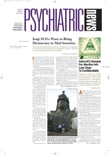What percentage of youth living in cities around the world have been exposed to, or victimized by, violence?
Anywhere from 9 percent to 42 percent of youth living in American cities, various studies have found; more than 50 percent of youth living in Colombia cities, an investigation has revealed (Psychiatric News, September 10, 2003); and more than 80 percent of youth living in Nairobi, Kenya, and in Cape Town, South Africa, according to a study reported in the February British Journal of Psychiatry.
This study was headed by Soraya Seedat, M.D., a psychiatrist and co-director of the Medical Research Council Unit on Anxiety and Stress Disorders at the University of Stellenbosch, South Africa. Two other collaborators were Caroline Nyamai, M.D., and Frank Njenga, M.D., psychiatrists from Chiromo Lane Medical Center in Nairobi, Kenya.
Seedat and her colleagues selected as subjects for their study 2,041 boys and girls from 18 schools in either Cape Town or in Nairobi. All youngsters were in the 10th grade, and their average age was 16 years. Most of the Kenyan students were black, whereas most of the South-African students were of mixed race, representing the majority ethnic groups in Nairobi and Cape Town, respectively.
The researchers then devised several questionnaires to obtain demographic information about the subjects and to learn about their exposure to violence and the effects of this violence on their mental health. The questionnaires included the Trauma Checklist, a list of traumas qualifying a person for a diagnosis of posttraumatic stress disorder according to DSM-IV criteria and adapted from the Schedule for Affective Disorders and Schizophrenia for School-age Children-Present and Lifetime; the Child PTSD Checklist, a 28-item structured measure developed to diagnose childhood and adolescent PTSD; the Life Events Questionnaire; and the Beck Depression Inventory.
The investigators then administered the questionnaires to their subjects, analyzed the responses, and compared results between the two groups of subjects—1,140 from Cape Town and 901 from Nairobi.
First, 83 percent of Cape Town teens and 85 percent of Nairobi teens reported exposure at some point in their lives to at least one type of trauma listed on the Trauma Checklist—for example, being robbed or mugged; being physically hurt or attacked; seeing family members injured, beaten, hurt, or killed; or witnessing violence on the street. The average number of trauma exposures was 2.5. For both Cape Town and Nairobi teens, the most common traumas were witnessing community violence, being robbed or mugged, and witnessing a family member being hurt or killed.
“We were not surprised by rates of violence exposure in Cape Town,” Seedat told Psychiatric News, “as previous studies have documented similarly high rates and especially in view of the high levels of criminal violence that prevails. However, we expected to find much lower rates of violent trauma in Kenyan youth.”
Second, even though Nairobi youth were exposed to the same high levels of violence that Cape Town youth were, actually even a little more, the former had a much lower rate of PTSD. Whereas 22 percent of Cape Town adolescents had a full PTSD diagnosis, only 5 percent of Nairobi adolescents did—a highly significant difference.
“This finding, too, surprised the researchers. I would suggest that the significantly lower rates of PTSD in the Kenyan sample may, in part, be attributable to less ‘toxic’ exposure to events, that is, less severe trauma and/or to protective peritraumatic or posttraumatic factors in the environment, for instance, more social or community support,” Seedat told Psychiatric News. “However, this is only a hypothesis, as in this survey a quantitative measure of trauma severity or examination of peritraumatic/posttraumatic factors was not done.”
Third, the researchers found there was no gender difference in the overall rate of PTSD. Some previous studies have found a much higher risk for PTSD in females.
A fourth unexpected result was that, while boys and girls were equally likely to have experienced at least one lifetime trauma, more boys than girls incurred sexual trauma. Nonetheless, the risk of developing PTSD following sexual assault was found to be the same for both genders. And when sexual assault was compared with other kinds of traumas, it was associated with the highest risk of PTSD, a finding paralleling that of other investigators.
“I hope that these results will increase awareness of the potential psychiatric sequelae of endemic violence exposure in African youth,” Seedat said. “Ultimately the goal is to have accessible and efficient trauma screening and intervention programs in place at school and in the community, and to have many primary health care workers and educators trained so that they are able to identify and refer traumatized youth with PTSD, major depression, substance use disorders, and so on for care.”
The study was funded by the Chiromo Lane Medical Center in Nairobi and the South African Medical Research Council Unit on Anxiety and Stress Disorders.
The British Journal of Psychiatry 2004 184 169
